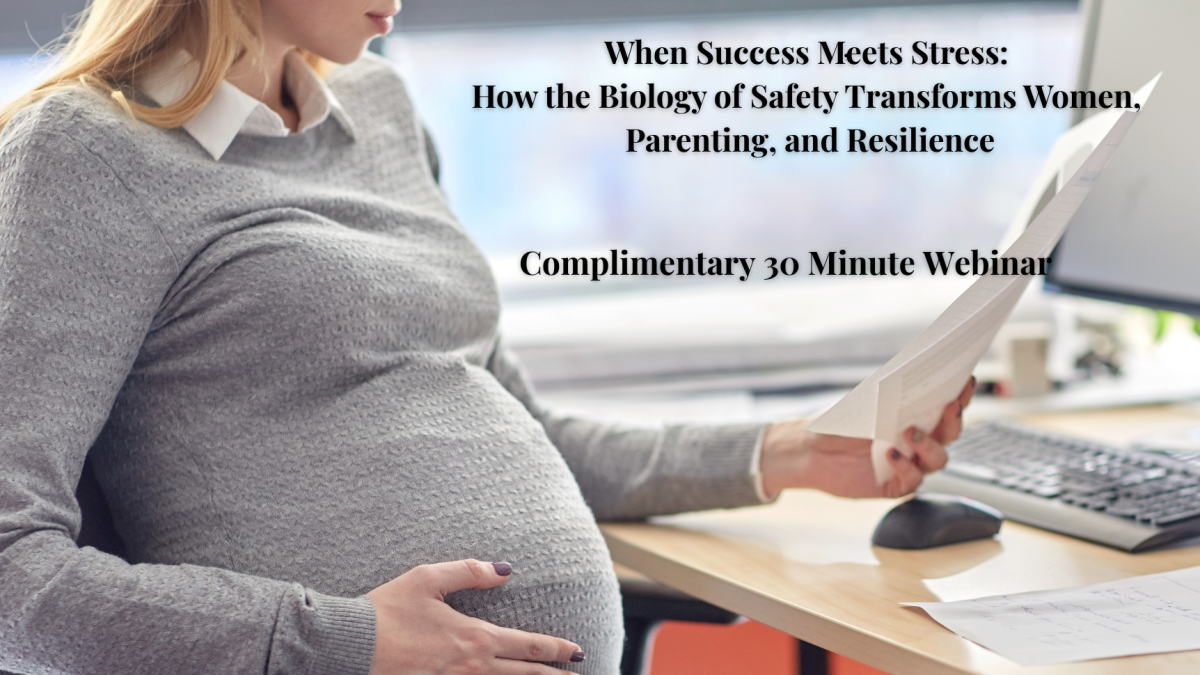How High-Performing Women Rewire Stress Into Resilience for Self & Family : The Biology of Safety

Because success shouldn’t come at the cost of health, connection, or the next generation.
When High Performance Breaks the Body
You tell yourself it's just stress.
You push through exhaustion, deadlines, kids, endless to-do lists. You run on caffeine, ambition, and white-knuckle willpower.
But then your body starts to push back.
Fatigue that sleep doesn't fix. A gut that never settles. Mood swings you can't explain. The quiet whisper of pain turns into a roar.
It feels random. But what if it's not? Your biology is keeping score. And what feels like "sudden health issues" may actually be your body carrying unresolved stories from decades ago.
The body isn't betraying you, it's carrying unresolved survival patterns.
Resilience Begins Before Birth and Grows With Us
Long before birth, a baby's nervous sytem is already at work. It's like the body's first survival toolkit, constantly adapting tothe world it encounters through the mother's body. Stress, sound, movement and even chemical exposures all leave an imprint. But, so do the positive experiences: warmth, calm, connection, and love.
And here's what's remarkable this adaptability doesn't end in childhood. Patterns formed early can shift later. Repetition of safety, co-regulation, and repair builds new survival strategies, ones rooted in resilience, not shutdown.
In other words: even if trauma shaped the beginning of the story, resilience can rewrite the ending.
How Childhood Stress Becomes Adult Disease
Adverse childhood experiences (ACEs) are not just difficult memories, they change the operating system of your body.
- Your nervous system learns to scan for threat instead of safety.
- Your mitochondria, those little power plants inside every cell, shift into survival mode, reducing energy for growth and repair.
- Your body initiates the Cell Danger Response, where cells physically change shape, hoard resources and signal "not safe" long after the threat has passed.
Nervous system + mitochondria = survival wiring.
This is why decades later, unresolved trauma can look like chronic fatigue, autoimmune conditions, digestive disorders, mood instability and more. It's not weakness. It's biology.
Parenting as a Biological Intervention
Here's the hope: biology is not destiny.
Picture this: Your toddler melts down in the grocery store. They are red-faced, shaking, crying in that primal, everyone's staring kind of way.
You feel your chest tighten, embarrassment rising, the old impulse to shut it down fast. But instead, you drop to their level, take a slow breath, and say quietly: "It's a lot right now, huh? I've got you."
They hiccup, lean into your steady presence, and slowly their breathing begins to match yours.
That moment? That's not just parenting. That's nervous system science in action. That's co-regulation, your calm body lending safety to theirs. Over time, these repeated micro-moments of saftey build the biology of resilience.
And here's the best part: you don't need to be a flawless, zen-like parent. Repair matters more than perfection. Presence outweighs performance. Every time you reconnect, you lay another brick in your child's secure foundation.
Science of Hope: Why Resilience Still Works
A recent study found that children who experienced emotional trauma were more likely to struggle with social distress and avoidance as teens. But there's a powerful twist: resilience skills buffered the damage.
Even children in difficult environments, such as "left behind" kids raised by absent parents due to work, showed improved outcomes when resilience was nurtured, thought the effect was weaker with consistent adult presence. The message? Resilience can't erase pain, but it can soften the impact and give those children more capacity to connect and cope.
And resilience is built in the everyday: bedtime routines, shared meals, a paren'ts hand on the shoulder during a meltdown, a hug.
Why Awareness Alone Doesn't Build Resilience
Many high-performing people learn about trauma later in life. Suddenly, everything makes sense, but awareness alone, doesn't repair biology.
That's the role of my Freedom Foundation: to create a framework that looks at the whole system, not just symptoms. (Adapted in part from the Biology of Trauma Framework)
- Create the biology of safety using repair tools (antioxidants, mitochondrial nutrients and nervous system practice).
- Identify your unique biological"stuck points" rather than a cookie cutter plan.
- Integrate your mind, body and biology...because trauma touches all three. Utilize regulation practices that work for you (breathwork, co-regulation, safe touch and titrated recovery).
Why This Matters for You
If you've been the one powering through, performing, excelling, achieving, and now your body feels like it's betraying you, know this:
- Your not weak.
- Your not broken.
- You're experiencing biology that can be restored.
What This Means for You
If you've ever worried, "Did I already mess this up for my kids?" take a breath. It is never too late to repair, reconnect, and build resilience. When parents regulate with their children, they don't just calm tantrums. They change trajectories. The rewrite family patterns. They stop trauma from becoming the family heirloom.
In my upcoming mini-course,When Success Meets Stress: How the Biology of Safety Transforms Women, Parenting, and Resilience, I'll show you:
- How to recognize the difference between stress and overwhelm (in yourself and your child).
- Simple, doable practices for co-regulation, even when you feel dysregulated.
- Why these everyday moments literally shape the brain for resilience.
Because resilience isn't something your child is either born with or not. It's something you build together, one nervous system , one moment, one generation at a time.
Naviaux, R. K. (2014).
Metabolic features of the cell danger response.
Mitochondrion, 16, 7–17.
https://doi.org/10.1016/j.mito.2013.08.006
Childhood Emotional Trauma Linked to Later Social Distress
Adapted in part from The Biology of Trauma
Categories: : ACEs, Attachment, Bonding, Resilience, Stress, Trauma
Sign Up for our Newsletter
Wellness rooted in safety and connection for families, moms-to-be, and childcare professionals. Science-based tools to ease stress, build resilience, and support healthy development.
 Vicki Johnson
Vicki Johnson 
